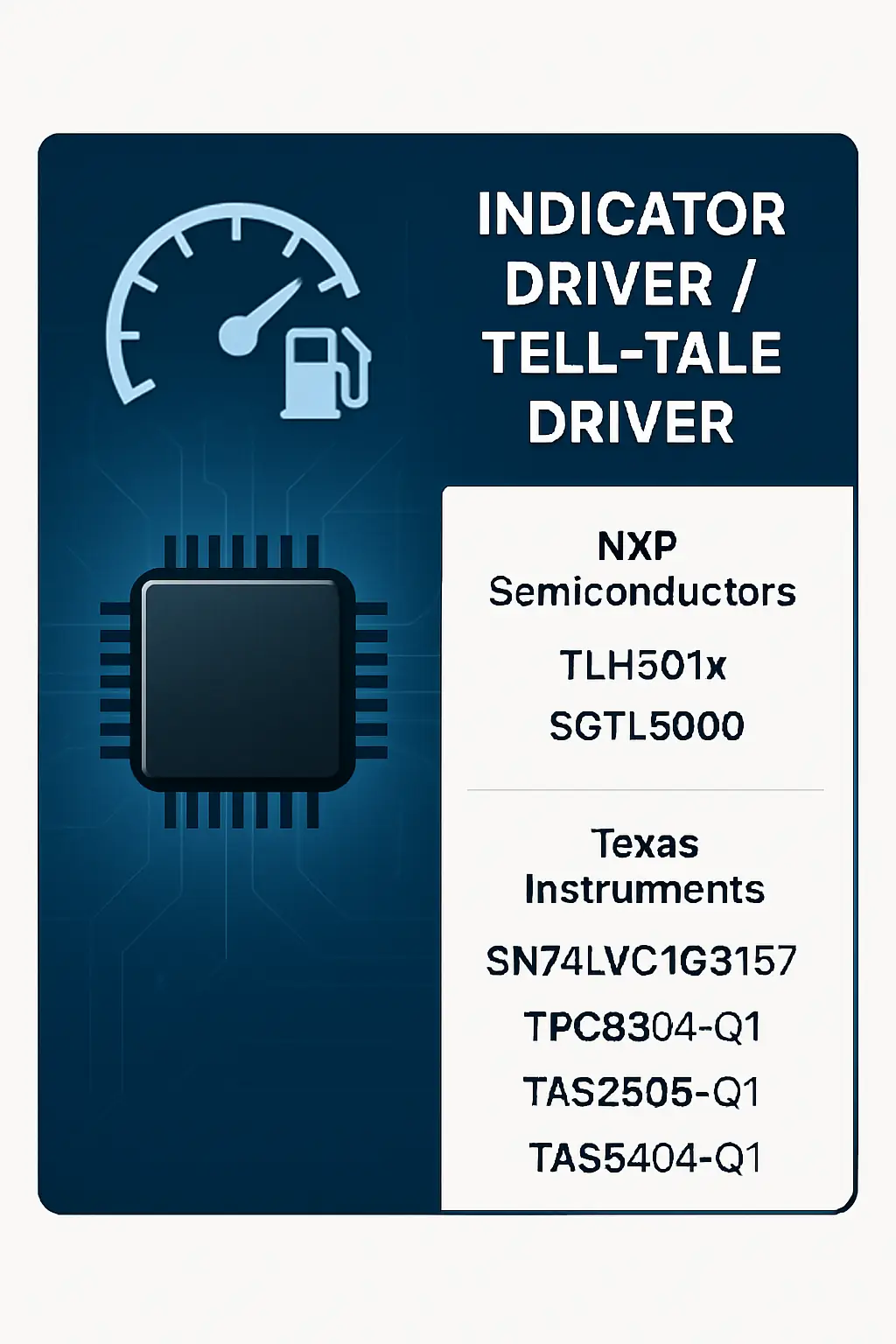Indicator Driver / Tell-tale Driver
The Indicator Driver / Tell-tale Driver is a critical component within the Digital Cluster & Display system of modern Infotainment & Digital Cockpit solutions in Automotive Electronics. It is responsible for controlling and displaying various vehicle status indicators, such as warning lights, fuel level, engine temperature, and other essential driver information on the digital dashboard. These indicators provide real-time feedback to the driver, enhancing situational awareness and safety.
This technology is widely used in advanced automotive systems, where traditional analog gauges are replaced by high-resolution digital displays. The Indicator Driver ensures accurate and reliable communication between the vehicle's control modules and the display unit, enabling dynamic updates and customizable layouts. It supports multiple signal inputs, including CAN bus, LIN, and direct sensor connections, making it compatible with a wide range of vehicle architectures.
Applications of the Indicator Driver include passenger cars, commercial vehicles, and electric vehicles, where clear and timely information delivery is crucial. It plays a key role in improving user experience by offering customizable dashboards, adaptive lighting, and seamless integration with other infotainment features. With the rise of connected and autonomous driving technologies, the importance of efficient and responsive indicator systems continues to grow. This component not only enhances driver safety but also contributes to the overall sophistication and functionality of the digital cockpit, meeting the evolving demands of modern automotive design.
Details
Indicator Driver / Tell-tale Driver

Related Parts
| Series Name | Description | Manufacturer Name | Attribute Description |
|---|---|---|---|
| NXP Semiconductors | 1.8V to 5.5V supply voltage; 1.2ns propagation delay; 200Mbps data rate; low power consumption; available in SOT23 and XSON6 packages; suitable for digital isolation applications. | ||
| NXP Semiconductors | 24-bit stereo audio codec, 48 kHz sample rate, low power consumption, integrated PLL, I2S/PCM interface, 1.8V–3.6V supply, embedded digital signal processing. | ||
| Texas Instruments | Single-pole double-throw analog switch, 2.7V to 5.5V supply, low on-resistance, 1.8V CMOS compatible, ESD protection, high bandwidth, SOT-23 package. | ||
| Texas Instruments | 4-channel Class-D audio amplifier, 4.5V to 18V supply, 2×50W/4Ω or 4×25W/4Ω, 90% efficiency, integrated protection, wide PSRR, low THD+N, I²C diagnostics, AEC-Q100 qualified. | ||
| Texas Instruments | 2.1W mono, 4.5V to 18V input, I2C interface, spread-spectrum PWM, integrated boost converter, digital input Class-D amplifier with speaker DC protection and fault reporting. | ||
| Texas Instruments | 1.8V to 5.5V operating voltage, 2.5W mono speaker driver, integrated boost converter, 90% efficiency, THD+N 1%, shutdown current <1μA, built-in protection, WSON-8 package. | ||
| Texas Instruments | 4-channel digital input Class-D audio amplifier, 2.1 MHz PWM, 4.5V to 18V supply, I2C control, integrated boost converter, 32-VPP output, AEC-Q100 qualified for automotive use. | ||
| Texas Instruments | 2.1W stereo or 4.2W mono digital input Class-D amplifier, 4.5V to 26V supply, I2S/Left-Justified digital audio input, 32–192 kHz sample rate, integrated DSP, high PSRR, low THD+N. | ||
| Texas Instruments | Automotive-grade 12-bit, 1-MSPS DAC with I2C interface, ±1 LSB INL, 2.7V to 5.5V supply, -40°C to +125°C temperature range, low power consumption, integrated reference. | ||
| Texas Instruments | 24-bit FPD-Link III deserializer, 100 Mbps to 1.2 Gbps, operates at 3.3V, supports video and bidirectional control, -40°C to 105°C junction temperature, 40-pin WQFN package. |








.png?x-oss-process=image/format,webp/resize,h_32)










